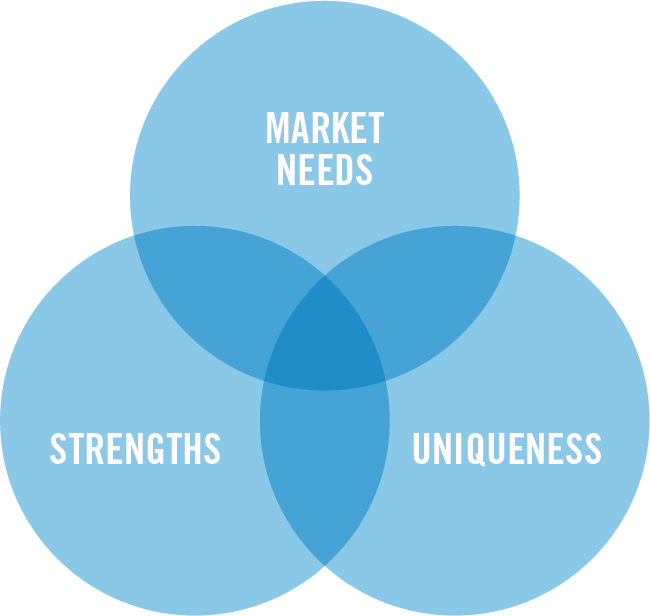One significant challenge facing private enterprises revolves around strategy. While most leaders feel strategy is critical to success, very few, including senior management and the board, can clearly articulate their strategy. Many leaders also struggle with how to deploy strategy in their business.
What is Strategy?
Despite how much the word strategy is used in regular business dialogue, strategy is often misunderstood. Many incorrectly believe that mission and vision are strategy. Mission defines why a business exists, and vision represents our dreams of what we want it to become. While immensely valuable, they do not define the strategy.
Another common misconception is that the business plan or strategic plan is strategy. A business plan or strategic plan clearly defines our intentions and what actions we intend to implement to achieve our goals. A good business or strategic plan defines how we achieve our strategy, but it is not strategy in and of itself.
A strategy defines how we will compete and win. It clearly articulates our unique value proposition in the market and the choices we will make to grow our business and achieve our goals. Strategy crafts future decisions by providing boundaries or guideposts with which we can evaluate the allocation of scarce resources.
One of the best questions to ask is “Can every member of the leadership team clearly and succinctly articulate the strategy of the business in a one-line elevator pitch?” Most have a very hard time with this question. Can you state the strategy that clearly defines your organization’s differentiated competitive advantage?
Boards of directors, both fiduciary and advisory, also have a very difficult time with this question, which is interesting because high-performing boards believe they should spend most of their time on strategy. How can they do so if they cannot clearly and confidently state the strategy?
A strategy defines how we will compete and win.
How Do You Develop Strategy?
The best way to define your strategy is to articulate what your organization does well (your strengths) that the market values (market need) and that is different from competing alternatives (uniqueness). Your strategy should live in the sweet spot in the middle of the Venn diagram. Achieving only two of the three criteria leaves you with a weak strategy. For example, excelling at something that the market cares about, but that your main competitors also do well, will leave you in a commoditized world where differentiation is difficult.

To articulate your strategy, build a list in each circle and then look for the items that show up consistently across all three.
Rarely does an organization have more than two or three items that show up in the heart of the Venn diagram. The foundation for your strategy lies here.
Confirming strengths and market needs is typically easier than finding something compelling that is also different from what competitors are offering. With that said, you would do best to seek market feedback as part of your strategy development process to ensure you aren’t overstating your strengths or making false assumptions about what the market really values. An independent and objective approach to market research is critical to obtaining unbiased market input as you build your strategy.
Strategy Also Requires Making Difficult Choices
Defining a clear strategy requires your organization to focus and intentionally leave out good alternatives. If you are not saying no to something, you have not defined a clear strategy. Choosing between a great alternative and a poor one is not strategy. Choosing between three strong alternatives is when you are making strategic choices that will allow your organization to focus and win in the market. Focus and a willingness to make bold choices are often at the heart of good strategy.
Another Mistake With Strategy is Only Focusing on the Current Reality
Many businesses default to a strategy of optimizing the status quo. You need to look forward as you build your strategy.
“If it ain’t broke, don’t fix it” is not a philosophy that serves companies well when it comes to strategy. Many Alberta businesses excelled from 2010 to 2014 but were lulled into a false sense of security and allowed great results to disguise a lack of strategy. Do not mistake a strong tailwind today for good strategy that will serve you well tomorrow. Leaders need to ask themselves “What is the strategy that will allow us to win both today and tomorrow?” and “How much must we continue to evolve our strategy to ensure we don’t get left behind as conditions change?”
Finally, Strategy Should Guide All Key Business Decisions
Introducing new products, making senior hires, entering new markets, and acquiring new companies should all be decisions driven by your strategy, rather than reasons to rewrite your strategy. Too often, business decision makers become enamoured with a new opportunity and look for reasons to justify pursuing it, rather than letting their strategy determine whether they should move down a particular path.
Strategy Requires Focus, the Courage to Make Difficult Choices and the Discipline to Stay the Course
Organizations that define their strategy and stick to it find themselves more in control of their business, and not reacting to every new development in the market.
What is the Board’s Role in Strategy?
With a typical private company board meeting four to six times per year, how can it realistically contribute to strategy? A great board does not just review and approve a strategic plan or annual budget—it contributes to its design through critical thought and insight.
Differentiate Between Strategic Planning and Strategic Thinking
It is valuable to view conversations on strategy through the lenses of strategic planning (how and when) and strategic thinking (what and why). Management and the board both contribute to strategic thinking and planning. However, management will focus the most time on strategic planning—an evolutionary process determining what resources we are going to invest to achieve outcomes, typically resulting in a strategic plan. High-performing boards invest a significant amount of time in strategic thinking—applying insight and foresight to imagine possibilities, contemplate risks, and challenge management’s thinking.
The board should add value to the conversation through healthy skepticism and critical thought. Board members should challenge our choices, exploring why we are in the markets we are choosing to play and why we are not in other markets. They explore “What if?” scenarios, helping management assess what could go wrong and what options we have. Management should walk out of a board meeting with more energy and resolve regarding the strategy, and renewed focus on what they do not know and what they need to figure out.
Treat Strategy as a Process, Not an Event
Most organizations think of strategy as an activity resulting in a published document and a budget. High-performing organizations treat strategy as a verb—an active part of their culture and ongoing conversations. It may be structured, perhaps with a board calendar outlining planned strategic conversations at each meeting. It may also be unstructured, with informal conversations about risk and opportunities being actively encouraged.
Where to Go From Here?
Private company owners, management teams, and boards all have an important role to play in crafting strategy. If you are new to strategy or feel that your company lacks a clear strategy, here are a few steps that you can take to get started:
- Ask your leadership team and board to independently tackle the Venn diagram exercise. Compare and discuss differences, and identify what you are confident about and where you are making assumptions.
- Undertake market research to test those assumptions and gather feedback to further inform the process.
- Gather your leadership team and board for a facilitated off-site retreat where multiple strategy scenarios can be explored. Start first with possibilities, then prioritize a handful, and ask management to conduct additional due diligence to further refine and confirm your strategy.
- Articulate your strategy in a one- or two-line elevator pitch and share widely with relevant internal stakeholders to ensure alignment throughout the organization.
- Seek help—it is often difficult to see the forest for the trees, and outside advisors can support and facilitate better decision making.
Strategy is a complex topic but also a powerful tool in any organization. It is a journey with no defined ending—the key is embarking with the first step by challenging the status quo.
A well-defined strategy along with a culture of strategic thinking is an effective way to focus and empower an organization, driving long-term value.
Download your full copy of this article here:
About the Authors
Ted Kouri, BCom, MBA
As founder and president of Incite, Ted brings over 25 years of strategic marketing and consulting experience to the table. An active community volunteer, Ted has chaired a number of Boards, including Edmonton Community Foundation, AIESEC Canada, and Synergy Network. Incite advises a wide range of private sector clients to help them address challenges and capitalize on opportunities related to growth, post-merger integration, strategic communications, and business planning.
Darren Rawson, P.Eng., ICD.D
Darren is a Principal at Ozone Advisory Group, helping private company boards add value to enterprises and pursue high-performance. He is a proven executive with 17 years’ experience as CEO of mid-sized companies and has been doing business internationally for over 22 years throughout the Americas, Asia, and Europe.
Darren is an active Corporate Director and Board Chair, sitting on numerous private and non-profit boards. He is Vice Chair at the Edmonton chapter of the Institute of Corporate Directors and teaches at Executive Education at the University of Alberta’s School of Business.
To learn more, please visit ozoneadvisory.com





